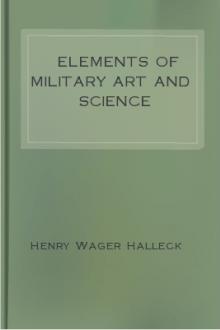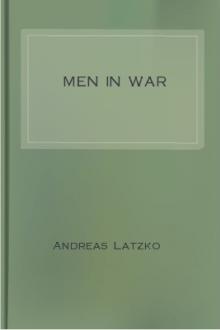Elements of Military Art and Science by Henry Wager Halleck (books you have to read txt) 📕

- Author: Henry Wager Halleck
- Performer: -
Book online «Elements of Military Art and Science by Henry Wager Halleck (books you have to read txt) 📕». Author Henry Wager Halleck
The materiel of artillery employed in modern warfare is divided into two general classes: 1st. Siege Artillery, or such as is employed in the attack and defence of places. 2d. Field Artillery, or such as is used in battle, or in the field-operations of an army.
1. Siege Artillery is composed of mortars, large howitzers, Paixhan guns or Columbiads,[34] and all cannon of a large calibre. In our service this class of ordnance includes the twelve, eighteen, twenty-four, thirty-two, and forty-two-pounder guns, the eight, ten, and thirteen-inch mortars, the sixteen-inch stone mortar, the twenty-four-pounder coehorn mortar, the twenty-four-pounder carronade, and the eight, ten, and twelve-inch howitzers.
[34]
These pieces were first invented by Colonel Bomford, of the U.S. army, and used in the war of 1812. The dimensions of these guns were first taken to Europe by a young French officer, and thus fell into the hands of General Paixhan, who immediately introduced them into the French service. They were by this means first made known to the rest of Europe, and received the name of the person who introduced them into the European services, rather than that of the original inventor. All these facts are so fully susceptible of proof, that Europeans now acknowledge themselves indebted to us for the invention; even General Paixhan gives up all claim to originality in his gun, and limits himself to certain improvements which he introduced. The original gun, which was invented by Colonel Bomford, and whose dimensions were carried to General Paixhan in France, is now lying at the ordnance dépôt, in New York harbor.
All these, except the smaller mortars, are made of cast iron. This substance is less tenacious than wrought iron or bronze, and the cannon made of it are, on this account, much heavier than of the other materials; but for the naval service, and the attack and defence of fortifications, the weight required to secure the necessary strength is not very objectionable. Wrought iron and bronze are much more expensive and less durable. Moreover, the difficulty of forging wrought iron in masses of sufficient size has been such as to prevent its being brought into general use for artillery. Numerous attempts have been made, at different periods, to construct large guns of this material, but none have yet been successful. Improvements which are now making in the manufacture of wrought iron, may render this the preferable material for the smaller pieces of artillery; but the best informed military men deem it objectionable for the heavier cannon, both on account of its cost and the imperfection of its manufacture. Even should the latter objection be removed, its cost must prevent its general application to the construction of siege artillery. Charlatans in military science, both in this country and in Europe, bring this subject up every fifteen or twenty years as a new invention, and flaming notices of the improvement, and predictions of the revolution it is to effect in the art of war, are circulated in the newspapers to "gull" a credulous public; and after some fifty or one hundred thousand dollars have been squandered on some court-favorite, the whole matter ends in the explosion of the "improvement," and probably the destruction of the "inventor," and perhaps also of his spectators. Let us be distinctly understood on this subject. There may be inventions and improvements in the manufacture of wrought iron, but there is nothing new in its application to the construction of cannon, for it has been used for this purpose as long ago as the first invention of the art.
2. Field Artillery is composed of the smaller guns and howitzers. In our service this class of cannon includes the six and twelve-pounder guns, and the twelve and twenty-four-pounder howitzers. All these are now made of bronze. This material is more expensive than cast-iron, but its superior tenacity renders it more useful where great weight is objectionable. Improvements in the manufacture of cast iron may render it safe to employ this metal in the construction of field-pieces. It is also possible the wrought iron may be forged in masses large enough, and the cost be so reduced as to bring it into use for field-pieces. It is here important to combine strength with lightness, and additional expense may very properly be incurred to secure this important object.
The projectiles now in use are solid shot, shells, strap-shot, case or canister-shot, grape-shot, light and fire-balls, carcasses, grenades, and rockets.
Solid shot are now almost invariably made of cast iron,[35] formed in moulds of sand or iron. This projectile is used under almost every circumstance, whether in the battle-field or in the attack and defence of places, and is the only one that is effectual against the stone walls of forts. Hot shot are used against shipping and wooden structures of every description. Red-hot balls were first employed by the king of Poland, in 1575, but, on account of the difficulty of heating them with rapidity, and the danger of loading the piece with them, this kind of projectile was not in general use till a much later period. It was at first supposed that the expansion of the metal would be so great, when heated to a red or white heat, as to prevent the ball from entering the piece; it is found, however, that the windage is still sufficient for loading with facility. These red-hot balls are principally used to fire wooden buildings, ships, and other combustible matter. They are therefore much used as a projectile for coast defence, and all fortifications on the seaboard should be provided with furnaces and grates, arranged so as to heat them with facility and rapidity.
[35]
In Mexico, where iron is scarce, copper is used for shot and shells; but it is a poor substitute.
There are several kinds of hollow-shot and shells, called bombs, howitzes, grenades, &c. They are made of cast iron, and usually in a spherical shape, the cavity being concentric with the exterior surface. The cavity was formerly made eccentric with the exterior, under the belief that the heavier side would always strike first. The rotary motion of the shell during its flight rendered this precaution of no use. Fire is communicated to the combustible matter within the shell by means of a fuse, which is so regulated that the explosion shall take place at the desired moment. Hollow-shot are used with advantage to destroy ordinary buildings, ships, earthwork, and thin walls of masonry; they, however, are of little avail in breaking the massive walls of well-constructed forts. Howitzes and grenades are particularly effective against cavalry and columns of infantry, and are much employed on the battle-field; they are also much used in the attack and defence of places.
We find that as early as 1486 the Spaniards made use of a projectile similar to the modern bomb. "They threw from their engines large globular masses, composed of certain inflammable ingredients mixed with gunpowder, which, scattering long trains of light," says an eye-witness, "in their passage through the air, filled the beholders with dismay, and descending on the roofs of edifices, frequently occasioned extensive conflagration." In the siege of Constantinople by Mahomet II., shells were used, and also mortars of enormous size. In 1572 Valturus proposed to throw, with a kind of mortar, "globes of copper filled with powder." In 1588, an artificer of Venloo burned Wachtendeck by throwing bombs into the place. A similar attempt had just been made at Berg-op-Zoom. The use of this projectile became quite common in France under Louis XIII. Howitzes were not much used till the seventeenth century. They are of German origin, and the howitzer first bore the name of hausmitz.
The strap-shot consists of a round ball attached to a sabot of the same calibre, by means of two strips of tin passing over the shot at right angles, and fastened to a third, which is soldered around the sabot. One end of the sabot is arranged for attaching it to the cartridge, the other being hollowed out to receive the shot. The supposed advantages of this arrangement are, 1st, a diminution of the windage; 2d, the gun may be loaded with greater rapidity; and, 3d, the cartridge is transported with greater safety.
The case or canister-shot is prepared by filling a tin canister with grape-shot or musket-balls, and attaching it to the cartridge by means of a sabot. There being two sizes of grape-shot, and one of musket-balls, we have three kinds of canister-shot calculated to reach at different distances. The three sizes of shot are frequently mixed in the same canister. This projectile is particularly effective against lines of infantry and cavalry, when the distance is short.
The grape-shot is composed of small balls arranged round an upright pin attached to a plate of wood or iron. The concave cast-iron plate is preferable, as it increases the range of the shot. The balls are covered with canvass, and thoroughly confined by a quilting of strong twine. This shot is used for the same purposes as the canister.
Light and fire-balls are formed of an oval case of sacking, filled with combustible matter, and attached to a culot of cast-iron. The whole is covered with a net of spun-yarn. Light-balls are used to light up our own works, and are not armed; fire-balls being employed to light up the works or approaches of an enemy, it is necessary to arm them with pistol-barrels, in order to prevent, any one from extinguishing them. When made of very combustible materials, and used for setting fire to wooden structures, they are denominated incendiary balls.
Carcasses are employed for the same purpose as incendiary balls; they are of two kinds: 1st, the shell-carcass; and, 2d, the ribbed-carcass. The first is composed of a spherical shell, cast with five fuse-holes, one being at the top, and the other four in a plane perpendicular to this and at right angles with each other; the shell is filled with matter highly combustible. The second is formed of iron ribs connected by iron straps, and attached at the ends to culots of the same material, the whole being filled with combustible composition. This is more expensive than the shell carcass, and cannot be fired with as great accuracy; it is now seldom used. Carcasses may be armed in the same manner as fire-balls.
Smoke and suffocating balls are used to drive an enemy from galleries and mines. They are thrown by hand.
The personnel of the French artillery was for a long time retained, together with the engineers, under the general direction of the "Grand Master of Cross-bows." In 1420 the master-general of artillery was made independent of the grand-master of cross-bows; but previous to the reign of Louis XIV., the artillery troops had no organization as a separate corps. In 1668 six companies of canoniers were created, and soon after two companies of bombardiers. In 1693 the first regiment of fusiliers was changed into a royal regiment of artillery, and both the canoniers and bombardiers were eventually incorporated with it. The staff of artillery, towards the close of this reign, was composed of one grand-master, sixty lieutenants, sixty commissaries, and eighty officiers-pointeurs. In 1721 the artillery was divided into five battalions and stationed at Metz, Strasbourg, Grenoble, Perpignan, and La Fère, where they established schools of theory and practice. In 1756 the artillery was organized into seven regiments, each regiment having its own separate school. This organization continued without any remarkable change till the Revolution.
During the earlier campaigns of the French Revolution it is impossible to trace out the changes that took place in army organization, every thing was then so irregular and confused, the troops of different arms being frequently united





Comments (0)